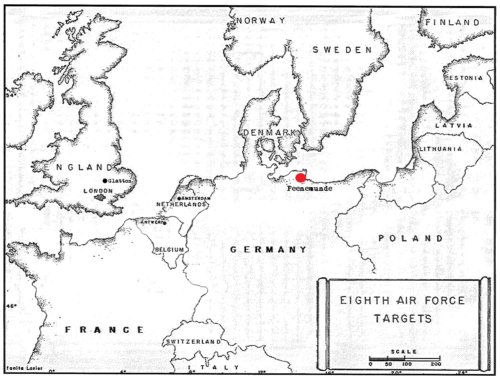TARGET: FUEL PLANT
PEENEMUNDE, GERMANY
18 JULY, 1944

Intelligence reports indicated the Me-I 63 rocket fighter had become operational. Four airfields in northern Germany had been equipped to service these planes. Peenemunde, the experimental station and birthplace of this plane, was now engaged in large scale production of concentrated hydrogen peroxide, the fuel used by this plane. The Me-163s were a threat to heavy bomber formations, and neutralization of the fuel plant had become a necessity.
The 457th Group supplied two eighteen plane high boxes, one each to the 94th A and B Combat Wings, the A box leading in a force of 450 B-17s to this target. Major George A. Beere and Lt. Norman Erbe led the A box, which was to bomb one of the electrostatic hydrogen peroxide plants, while Captain Beicher led the B box, which was to attack the power plant supplying electricity to the former.
After assembly into their respective Wing formations, the two formations left on a route across the North Sea to the Danish Peninsula. The ten-tenths undercast over the Sea decreased to between five and seven-tenths as Kiel was passed on the right. Continuing eastward over the Baltic Sea, the cloud coverage was on the borderline between visual and PFF bombing. As the turn was made at the IP for the bomb run, instructions were given for a visual position in the formation and drop on smoke markers if the target was obscured. However, as the target was approached the cloud cover was insignificant and bombs were dropped on and around the peroxide plant.
The bomb pattern of the B box was rather widespread, missing the power plant and falling to the east. There was veiy little flak and it was inaccurate. Only one plane received damage, and that was minor.

